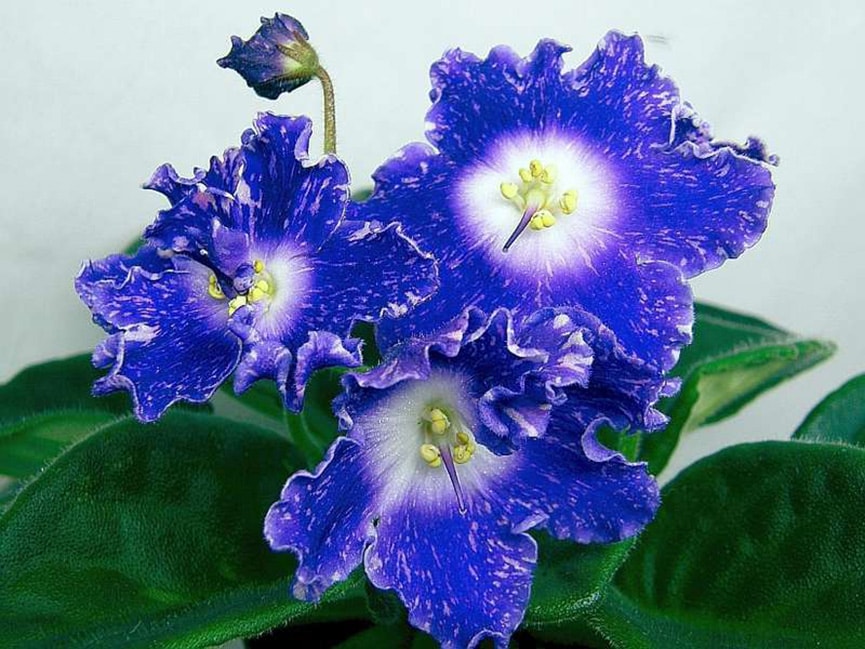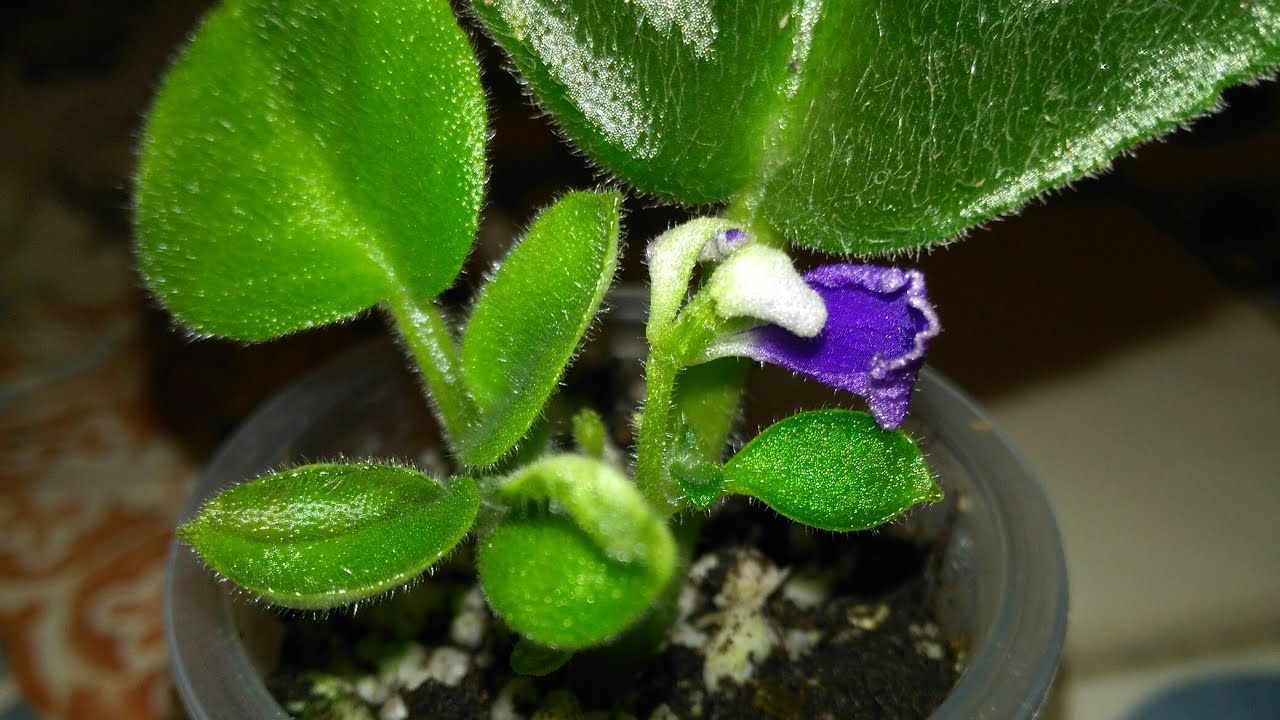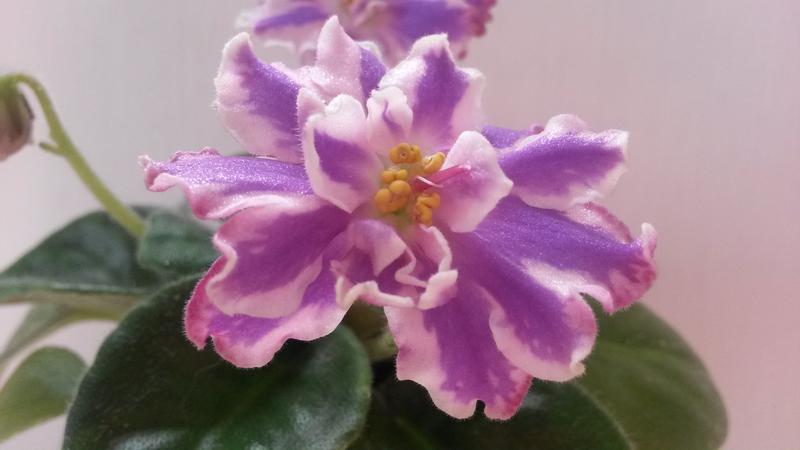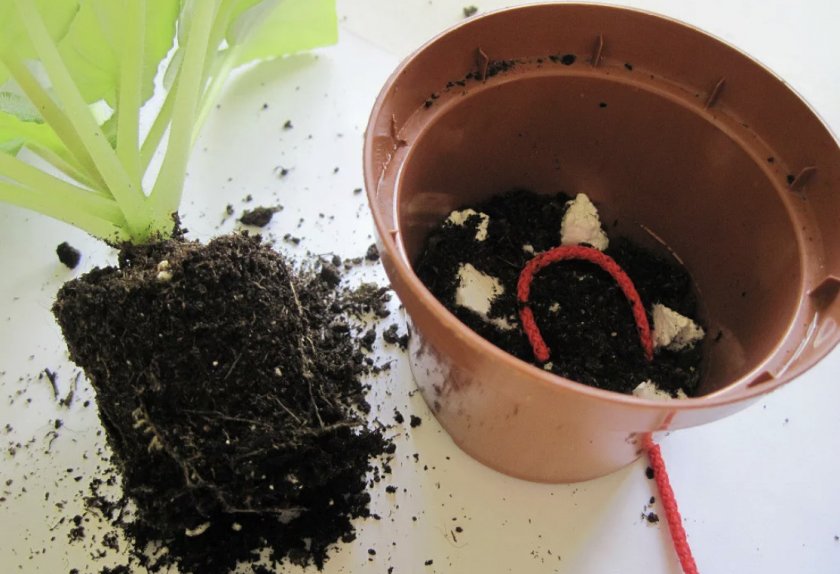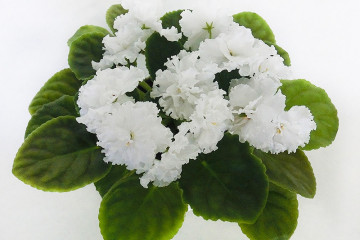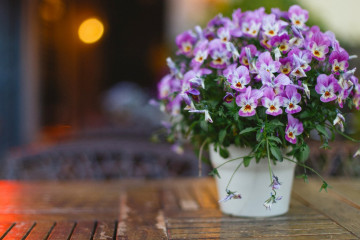Violet Shining Bell - variety description
Content:
According to ancient beliefs, violets provide order in the house and contribute to maintaining the relationship of its inhabitants at a good level, generating positive energy. DS Shining Bell was a relatively new variety that looks good on windowsills and balconies. Its flowers of a rich shade give the impression of comfort and harmony. With proper care, these nourishing uzambara flowers can please the eye all year round.
What does the violet DS look like?
Violet The Shining Bell belongs to the genus Saintpaulia, belonging to the Gesneriaceae family. Saintpaulia, also called Uzambara violet, is a herbaceous perennial plant native to the African tropics, in other climates it is grown only in greenhouse or indoor conditions.
This variety looks smart and bright. Flowers of the variety have a dark blue color, turning into a purple hue, they grow in the form of sweeping wavy bells. Some of them have a narrow whitish edging, the same color has a flower eye. This produces a subtle radiance effect.
Distinctive features of the variety
Violet Bellflower can bloom throughout the year, taking a break for only two months. Violet bells are in a partially open state most of the time, opening completely only before wilting begins. Flowering shoots grow straight up, having three buds on each. On the lamellar leaves of the plant, the relief is very poorly discernible, they are smooth and even at the edges.
How did the variety appear
Violet DS Shining Bell was brought out and entered into the register by the Ukrainian flower specialist E. Enikeeva. This type of violet was created by breeding and registered in 2014. Despite the breeding approach to creating a variety, this type of violet generally blooms without changes.
Grooming at home
For healthy growth and flowering of this Saintpaulia, it is necessary to observe such nuances as air humidity, soil type, top dressing, correct temperature, regular spraying and watering. To prevent the plants from drying out and stretching, you should choose the right lighting, and these flowers also need protection from pests and diseases.
Acceptable temperature
The temperatures required for these tropical plants to bloom range from 18-22 ° C. At lower rates, violets begin to hurt. Flowers do not tolerate cool drafts, so it is not recommended to place them at the door. Normal growth and flowering are also not guaranteed at temperatures above the allowable limits.
What kind of lighting is required
Plants of the Gesneriaceae family love good lighting, but under the direct rays of the sun, the leaves turn yellow, which is why the northern and eastern sides of the house will be the most optimal location for them. They feel good under the light of 40 W energy saving lamps, 12 hours daily is enough.
Watering nuances
The ideal time for watering is when the ground surface dries up. In winter, DS Bellflower violets are watered once a week, in other seasons two times are enough. The most optimal method is to fill the sump with water that has stood for several days for an hour. This time should be enough to saturate the soil with moisture to its surface. The water can be enriched with mineral additives, the rest of the liquid should be removed from the sump.
Professional florists use the wick irrigation method using rolled up nylon stockings. The wick protrudes halfway from the bottom hole of the pot, descending into the constantly present water, its thickness is responsible for the rate and amount of water absorption. It is adjusted according to the flower's requests.
Violets do not tolerate soot, gas vapors, grease and scale well, which is why they have no place in the kitchen and in similar rooms.
Is it worth spraying
Violets are sprayed with appropriate products only in case of disease or pest infestation. In case of a lack of moisture, the procedure will not raise it to the required level; moreover, it can cause rotting at the bases of leaves and bells. In this case, it is allowed to clean the flower from dust with a weak warm shower every three months.
Required humidity
Room air, especially in winter, is not humid enough for the normal growth of violets, they need 50-70%. However, this can be easily remedied by placing sand under the pots to cover the moistened expanded clay.
Another way to increase humidity is to place a container with water near the flower; it is often used during abnormal heat or heating season.
Recommended primer
Soil for violets is selected depending on the method of irrigation, it is often store-bought. For the substrate, when watering under leaves or in a pallet, you will need 3 parts of vermiculite or perlite, deciduous earth and peat, as well as 2 parts of sphagnum moss. Wick irrigation will require equal proportions of peat and perlite, in some cases they are supplemented with moss, but it absorbs and retains moisture.
What and how they feed Saintpaulias
Due to the large flowering period, this variety needs regular soil enrichment with minerals. Saintpaulias are fed every two weeks for five months, starting in May and ending in September. In the absence of flowering in winter or when flowering stops, feeding should be suspended.
The concentration and schedule of fertilizer use differ depending on the irrigation method. When watering the soil or filling the pan, the violet is fed every two weeks in the summer and once a month in the winter. In both cases, half of the manufacturer's recommended amount of fertilizer should be applied. With wick irrigation, feeding is carried out constantly in an amount of about 1/7 of the recommended volumes.
Flowering specifics
The plant grows rapidly and matures in the period from 10 months to a year. The first flowers appear in the sixth month. A compact rosette is formed from velvet leaves of a dark green color, in which from one to 10 stable flowering shoots are located.
What buds grow
The first flowers most often "sport", which is why violets of shapes and colors of other varieties may appear on the plant along with the standard buds of these Saintpaulias, the second flowering is dark blue flowers with a lilac tint and a white border and eye corresponding this selection. At the first flowering, chimeras, uneven blue and white colors, variegated or pink petals, as well as blurred forms of the flowers themselves are possible.
Flowering forms
The canonical form of flowers of this variety is a sweeping bell with wavy edges. This selection has long peduncles that form flowers at a low height. There are descriptions of the author's techniques of floriculture specialists, directing flowering in a nodding or crown manner.
How long does flowering last
These saintpaulias bloom for 9-10 months, followed by a couple of months break, after which flowering begins anew.
Rejuvenation
To keep the flower in shape, do not neglect the timely removal of wilted peduncles and flowers, third-party rosettes, as well as coarse or pale leaves. It is recommended to start rejuvenating in the second year of the plant's life, doing this in early spring.
Shrub propagation DS Shining bell
Saintpaulias of this variety are propagated by several methods, including planting side rosettes or peduncles, grafting and sowing seeds.
Germinating seeds
Sowing is a process that allows you to grow perfectly clean seedlings without chimeras, but it requires a decent amount of time and resources, which is why it is used mainly in greenhouses.
Cuttings
A new flower can be obtained by placing a leaf cut with a stalk in a glass of water. Within a couple of weeks, he will release roots, and he will have to be planted in a pot. After another couple of weeks, the new plant will begin to grow. Freshly planted cuttings need sparse and moderate watering.
How to transplant a plant
DS The shining bell needs a separate pot, spring is the best time to transplant into new soil. After laying on the bottom of the drainage layer, the substrate is poured from pieces of expanded clay or broken ceramics. Planting in a pot that is too bulky can prevent flowering, so some tightness is even welcome. The pot material can be either ceramic or plastic. Before transplanting, it is better to cover the bush with a package so that the earth does not get into.
What can interfere with the proper growth of the bush
Healthy flowers look right.
Diseases:
- withering lower leaves and the formation of a brown bush indicate a fatal late blight. It can be cured by watering with the addition of bravo, otherwise it is possible to save the top of the rosette and healthy leaves by rooting them in other pots with a preliminary treatment with 0.05% solution of the biosept drug or precursor according to the instructions. The soil affected by late blight is no longer suitable;
- brown leaves and flowers indicate gray rot.The flower should be set aside from others, the affected leaves should be removed and treated with euparen, rovral, kaptan or biosept twice a week;
- the leaves from below are covered with mucus and fall off with bacteriosis of the vessels of the bush, which often develops in hot rooms. Violet can be cured by means of Previcur, Zircon, Fundazol and Immunocytophyte;
- the appearance of a white coating indicates powdery mildew; to treat it, benlate or fundozol should be injected once.
Parasites:
- small nematode worms parasitize on the root system of the violet, poisoning it with their vital activity. The leaves are covered with light green and later darkening and decaying spots. The growth of the violet slows down, flowering stops, after which it dies. It is impossible to cure a bush from nematodes;
- cobwebs and red dots on the leaves are a consequence of mite infestation. The cuttings are covered with brown trenches. Leaves turn yellow and fall off. The flower stops growing and does not bloom. In this case, the bush is treated with an acaricidal agent twice a week;
- aphids cover the bellflower with light secretions, parasitizing on the terrestrial part of the plant, whose leaves lose their shape against the background of stopping growth. You can cure a violet with actellik or mospilan;
- if brown and drying leaves with moving dark dots are found, it is necessary to place insecticide tablets or capsules in the soil. These pests are small insect thrips.
DS The shining bell can get fungus if the temperature is too cool or too much water. Late blight can also develop from the latter, which can be insured by placing superphosphate in the soil. Violets are also threatened by almost any representatives of the Arthropod order.
Thus, there are many factors that must be considered in order for the Bellflower violet to bloom and develop. If you miss even one moment, it will quickly shed its buds and wither.

